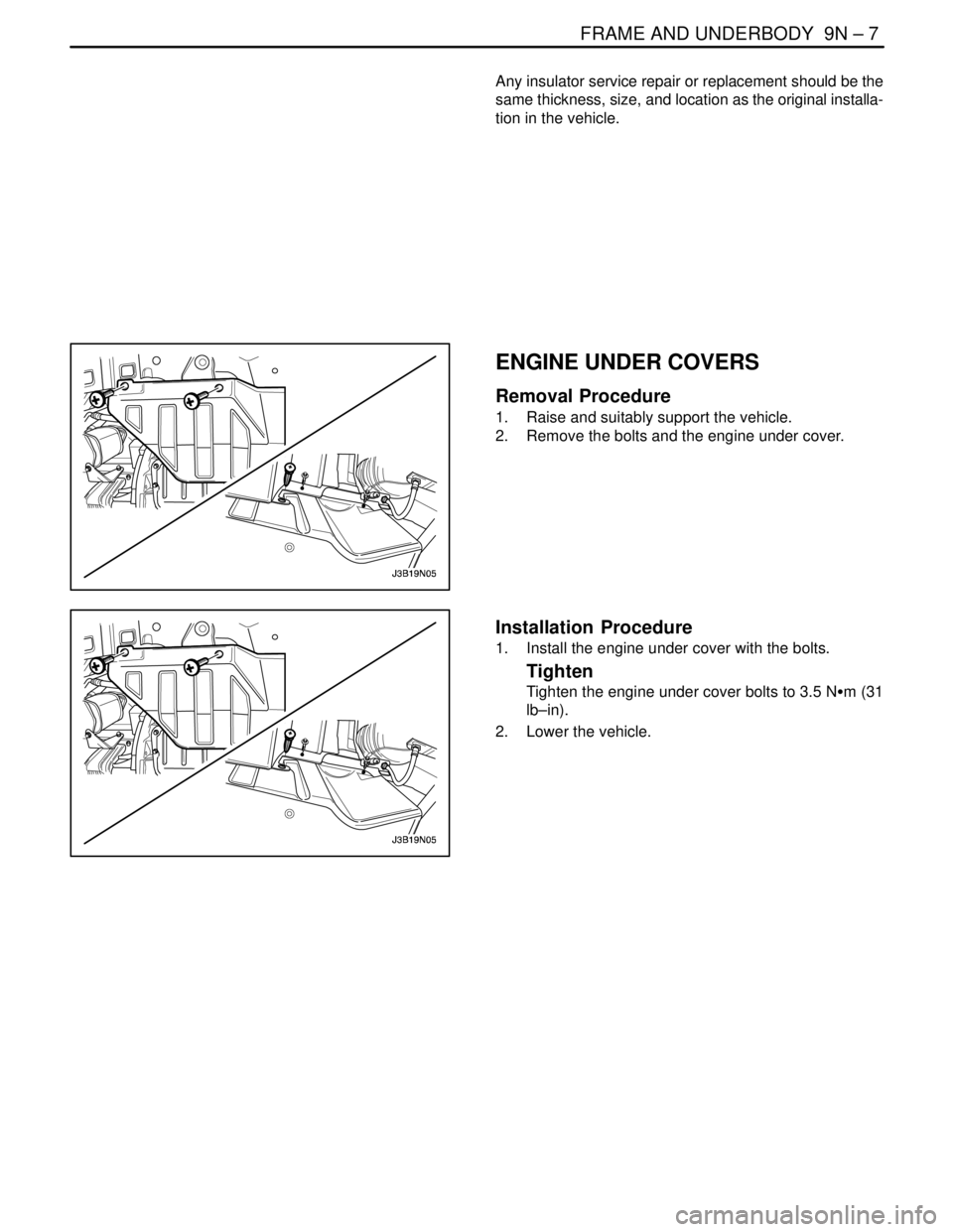2004 DAEWOO NUBIRA engine e
[x] Cancel search: engine ePage 2301 of 2643

9E – 2IINSTRUMENTATION/DRIVER INFORMATION
DAEWOO V–121 BL4
SPECIFICATIONS
FASTENER TIGHTENING SPECIFICATIONS
ApplicationNSmLb–FtLb–In
Air Deflector Screws2–18
Chime Module Screws4–35
Clock Screws2–18
Cupholder Screws2.5–22
Deposit Box Screws2.5–22
Driver Knee Bolster Bolts10–89
Floor Console Brace Bolts4–35
Floor Console Brace Nuts4–35
HVAC Controls Screws4–35
Instrument Cluster Screws4–35
Instrument Cluster Trim Panel Screws4–35
Instrument Panel End Bolts2015–
Instrument Panel End Screws4–35
Instrument Panel Nuts Above the Steering Column2015–
Instrument Panel Bolts Behind the HVAC Controls4–35
Steering Column Bracket Nut2216–
Steering Column Lower Trim Cover Screws2.5–22
Steering Column U–Clamp Nuts2216–
Steering Column Upper Trim Cover Screws3–27
INSTRUMENT CLUSTER INDICATOR LAMPS
SPECIFICATIONS
Indicator LampColorBulb
ABS WarningAmber14 v 1.4 W
Airbag WarningRed14 v 1.4 W
Battery Charge IndicatorRed14 v 1.4 W
Check EngineAmber14 v 1.4 W
Door Open WarningRed14 v 1.4 W
Engine OverheatRed14 v 1.4 W
Fasten Seat Belt WarningRed14 v 1.4 W
High Beam IndicatorBlue14 v 1.4 W
Low Fuel Level WarningAmber14 v 4 W
Oil Pressure WarningRed14 v 1.4 W
Parking Brake Indicator and Brake Fluid WarningRed14 v 1.4 W
Service Engine Soon WarningAmber14 v 1.4 W
Transaxle Power Mode IndicatorAmber14 v 1.4 W
Turn Signal IndicatorsGreen14 v 1.4 W
Page 2309 of 2643

9E – 10IINSTRUMENTATION/DRIVER INFORMATION
DAEWOO V–121 BL4
SPEEDOMETER
Speedometer Inoperative, Other Gauges and Warning Lamps Are
OK
StepActionValue(s)YesNo
11. Connect a scan tool.
2. Check for engine control diagnostic trouble
codes (DTCs).
Is the vehicle speed sensor DTC set?–Go to
Section 1F, En-
gine ControlsGo to Step 2
21. Turn the ignition OFF.
2. Disconnect the engine control module (ECM)
connector.
3. Remove the instrument cluster.
4. Check continuity between ECM terminal K6
(B23 ; HV–240, 51 ; SIRIUS D4) and the in-
strument cluster connector terminal B5.
Does the ohmmeter indicate the specified value?0 WGo to Step 4Go to Step 3
3Repair the open circuit between the instrument clus-
ter connector terminal B5 and the ECM.
Is the repair complete?–System OK–
4Replace the speedometer.
Is the repair complete?–System OK–
FUEL GAUGE
Fuel Gauge Inoperative, Other Gauges and Warning Lamps are OK
StepActionValue(s)YesNo
11. Connect a scan tool.
2. Check for engine control diagnostic trouble
codes (DTCs).
Is the vehicle speed sensor DTC set?–Go to
Section 1F, En-
gine ControlsGo to Step 2
21. Turn the ignition OFF.
2. Disconnect engine control module (ECM) con-
nector.
3. Remove the instrument cluster.
4. Check continuity between ECM terminal K30
(B31 ; HV–240, 40 ; SIRIUS D4) and the in-
strument cluster terminal B3.
Does the ohmmeter indicate the specified value?0 WGo to Step 4Go to Step 3
3Repair the open circuit between the instrument clus-
ter connector terminal B3 and the ECM terminal K30
(B31; HV–240, 40 ; SIRIUS D4).
Is the repair complete?–System OK–
4Replace the fuel gauge.
Is the repair complete?–System OK–
Page 2310 of 2643

INSTRUMENTATION/DRIVER INFORMATION 9E – 11
DAEWOO V–121 BL4
TEMPERATURE GAUGE
Temperature Gauge Inoperative, Other Gauges and Warning
Lamps are OK
StepActionValue(s)YesNo
1Allow the engine to cool to room temperature.
With the ignition ON, does the temperature gauge al-
ways read at the high end of the scale?–Go to Step 7Go to Step 2
2Disconnect ECM electrical connector.
Does the temperature gauge indicator drop to the
low end of the scale?–Go to
Section 1F, En-
gine ControlsGo to Step 3
3Check for a short to ground between the ECM and
the temperature gauge.
Is there a short to ground?–Go to Step 4Go to Step 5
4Repair the short to ground.
Is the repair complete?–System OK–
5Replace the temperature gauge.
Is the repair complete?–System OK–
61. Disconnect the ECM.
2. Turn the ignition ON.
3. Check the voltage at the ECM.
Does the the voltage equal the value specified?11–14 vGo to Step 9Go to Step 7
7Check for an open circuit between the ECM and the
temperature gauge.
Is there an open circuit?–Go to Step 8Go to Step 5
8Repair the open circuit between the ECM and the
temperature gauge.
Is the repair complete?–System OK–
91. Disconnect the ECM.
2. Connect a jumper wire between the ECM con-
nector and ground.
3. Turn the ignition ON.
Does the temperature gauge move to the high end
of the scale?–Go to
Section 1F, En-
gine ControlsGo to Step 5
Page 2329 of 2643

9E – 30IINSTRUMENTATION/DRIVER INFORMATION
DAEWOO V–121 BL4
GENERAL DESCRIPTION
AND SYSTEM OPERATION
CIGAR LIGHTER
The cigar lighter is located in the front portion of the floor
console. To use the lighter, push it in completely. When the
lighter is hot, it will release itself from contact with the heat-
ing element. The lighter and the heating element can be
damaged if the lighter is not allowed to release itself fully
from the heating element.
ASHTRAY
The ashtray is located below the audio system. To access
the ashtray, pull it out from the center console. The ashtray
lamp will go on when the parking lamps or the headlamps
are turned on.
INSTRUMENT PANEL VENTS
The center and the side vents in the instrument panel can
be adjusted up and down and from side to side. The side
vents can also be aimed toward the side windows in order
to defog them.
GLOVE BOX
The glove box can be opened by pulling up on the latch
handle. The glove box must be removed in order to gain
access to the passenger’s side airbag module.
DIGTAL CLOCK
The digital clock is located in the instrument panel, above
the audio system. The clock is capable of a 12–hour or a
24–hour display.
INSTRUMENT CLUSTER
The instrument cluster is located above the steering col-
umn and in the instrument cluster trim panel. The instru-
ment cluster contains the instruments that provide the
driver with vehicle performance information. The instru-
ment cluster contains a speedometer, an odometer, a trip
odometer, a temperature gauge, a fuel gauge, and several
indicator lamps. For replacement of the indicator lamp
bulbs contained in the instrument cluster, refer to ”Instru-
ment Cluster Indicator Lamps Specifications” and”Instru-
ment Cluster Indicator Lamps” in this section.
SPEEDOMETER/ODOMETER/TRIP
ODOMETER
The speedometer measures the speed of the vehicle in
km/h (mph in some countries). It consists of an instrument
cluster gauge connected to the vehicle speed sensor
(VSS) on the transaxle output shaft.The odometer measures in kilometers (miles in some
countries) the total distance the vehicle has traveled since
it was manufactured. It consists of an instrument cluster
gauge connected to the VSS on the transaxle output shaft.
The trip odometer measures the distance the vehicle has
traveled since the odometer was last reset. It consists of
an instrument cluster gauge connected to the VSS on the
transaxle output shaft. The trip odometer can be reset to
zero at any time so that the driver can record the distance
traveled from any starting point.
FUEL GAUGE
The fuel gauge consists of an instrument cluster gauge
connected to a sending unit in the fuel tank.
The fuel gauge indicates the quantity of fuel in the tank
only when the ignition switch is turned to ON or ACC.
When the ignition is turned to LOCK or START, the pointer
may come to rest at any position.
TEMPERATURE GAUGE
The temperature gauge consists of an instrument cluster
gauge connected to a temperature sensor that is in con-
tact with the circulating engine coolant.
The temperature gauge indicates the temperature of the
coolant. Prolonged driving or idling in very hot weather
may cause the pointer to move beyond the center of the
gauge. The engine is overheating if the pointer moves into
the red zone at the upper limit of the gauge.
INSTRUMENT CLUSTER INDICATOR
LAMPS
The instrument cluster contains indicator lamps that indi-
cate the functioning of certain systems or the existence of
potential problems with the operation of the vehicle. The
indicator lamps are replaceable. For replacement of the in-
dicator lamps contained in the instrument cluster, refer to
”Instrument Cluster Indicator Lamps Specifications”
and”Instrument Cluster Indicator Lamps” in this section.
CHIME MODULE
The chime module is located above the instrument panel
fuse block and will sound in order to bring attention to one
or more of the following conditions:
S The lamps are on, the door is ajar, and the ignition
switch is not in ACC, ON, or START.
S The seat belt is unbuckled when the ignition switch
is in ON or START.
S The door is open when the ignition switch is in ON
or START.
S The key is left in the ignition switch when the igni-
tion is in LOCK and the door is open.
Page 2378 of 2643

9K – 2ISQUEAKS AND RATTLES
DAEWOO V–121 BL4
Glass Knock Coming From the Rear of the Vehicle When Driving
Over Bumps
ChecksAction
Check for an out–of–adjustment hatchback latch.S Test drive the vehicle in order to verify this condition.
S Loosen the latch nuts and adjust the latch downward.
Rattle Coming From Door
Checks Action
Check the door lock solenoid.S Remove the door trim panel and check if the sole-
noid is loose.
S Tighten the solenoid bolts.
Check for rattling electrical connectors inside the door trim
panel.S Tap on the trim panel and listen for a rattle.
S Remove the trim panel and wrap foam padding
around the connectors as required.
Squeak When Operating Doors
ChecksAction
Check for a lack of lubrication of the door hinge pins.S Operate the doors and listen for squeaks.
S Lubricate the door hinge pins with light oil and coat
with lithium grease.
Squeak Coming From Console When Shifting Manual Transaxle
(Condition Occurs In Cold Weather with a Cold Engine)
Checks Action
Check the manual transaxle control lever lower boot.S Move the control lever between gears and listen for
squeaks.
S Remove the floor console and replace the lower shift
boot or apply talcum powder to the lower shift boot.
Buzz From the Left Side of Instrument Panel
ChecksAction
Check for vibration of the fuse box cover against the instru-
ment panel side trim.S Tap on the cover with a finger and listen for a buzz.
S Apply 6.35 mm (0.250 inch) by 25.4 mm (1.00 inch)
felt pads to the side trim where the cover makes con-
tact.
Squeak Coming From Instrument Cluster Trim Plate
Checks Action
Check for rubbing of the cluster trim plate on the instru-
ment panel.S Test drive the vehicle in order to verify this condition.
S Remove the instrument cluster trim plate and install
felt tape to the edges.
Page 2404 of 2643

SECTION : 9N
FRAME AND UNDERBODY
TABLE OF CONTENTS
SPECIFICATIONS9N–1 . . . . . . . . . . . . . . . . . . . . . . . . . .
Fastener Tightening Specifications 9N–1. . . . . . . . . . .
Notchback Underbody Dimensions 9N–2. . . . . . . . . . .
Hatchback Underbody Dimensions 9N–4. . . . . . . . . . .
MAINTENANCE AND REPAIR9N–6 . . . . . . . . . . . . . . .
ON–VEHICLE SERVICE 9N–6. . . . . . . . . . . . . . . . . . . . . Alignment Checking 9N–6. . . . . . . . . . . . . . . . . . . . . . . .
Floor Pan Insulators 9N–6. . . . . . . . . . . . . . . . . . . . . . . .
Engine Under Covers 9N–7. . . . . . . . . . . . . . . . . . . . . .
GENERAL DESCRIPTION AND SYSTEM
OPERATION9N–8 . . . . . . . . . . . . . . . . . . . . . . . . . . . . . .
General Body Construction 9N–8. . . . . . . . . . . . . . . . .
Engine Under Covers 9N–8. . . . . . . . . . . . . . . . . . . . . .
SPECIFICATIONS
FASTENER TIGHTENING SPECIFICATIONS
ApplicationNSmLb–FtLb–In
Engine Under Cover Bolts3.5–31
Page 2409 of 2643

9N – 6IFRAME AND UNDERBODY
DAEWOO V–121 BL4
MAINTENANCE AND REPAIR
ON–VEHICLE SERVICE
ALIGNMENT CHECKING
An accurate method of determining the alignment of the
underbody uses a measuring tram gauge. The tram gauge
set used to perform the recommended measuring checks
must include a vertical pointer able to reach 457 mm (18
inches).
Two types of measurements can be made with a tram
gauge: direct point–to–point measurements and mea-
surements calculated on a horizontal plane (datum line)
parallel to the underbody. Point–to–point measurements
are generally taken on steering and suspension engine
compartment parts and simply require the vertical pointers
to be set equally.
For horizontal plane measurements, the vertical pointers
must be set as specified for each point to be measured.
Dimensions–to–gauge holes are measured to the center
of the holes and flush to the adjacent surface metal unless
otherwise specified. It is recommended that the diagonal
dimensions to the cross–body be checked on both sides
in order to verify the dimensional accuracy of the vehicle
underbody.
FLOOR PAN INSULATORS
The floor pan insulators have been designed for the higher
floor pan temperatures that result from the use of the cata-
lytic converter in the exhaust system. Therefore, when
servicing a vehicle, it is essential that any insulators that
may have been disturbed or removed be reinstalled in the
original sequence and location. Also, if an insulator needs
to be replaced, use only the insulation specified for that
location on the floor pan.
When servicing or replacing interior insulators, observe
the following instructions.
S Install the insulators in the original position and se-
quence. Butt the pieces together in order to avoid
gapping or overlapping.
S If it is necessary to replace an insulator, use only
the specified insulation.
S Use the original part to determine the amount of
replacement material required and as a template for
cutting and fitting the new piece to the floor pan.
S When installing the insulator, do not enlarge any
cutouts or holes that are used for the attachment of
interior parts such as the instrument panel or the
floor console.
S Route the cross–body harness for interior parts
over the floor pan insulators. Clip it in the original
location.
S Do not apply spray–on deadeners or trim adhesives
to the top of the floor pan at the area directly over
the catalytic converter or the muffler.
Page 2410 of 2643

FRAME AND UNDERBODY 9N – 7
DAEWOO V–121 BL4
Any insulator service repair or replacement should be the
same thickness, size, and location as the original installa-
tion in the vehicle.
ENGINE UNDER COVERS
Removal Procedure
1. Raise and suitably support the vehicle.
2. Remove the bolts and the engine under cover.
Installation Procedure
1. Install the engine under cover with the bolts.
Tighten
Tighten the engine under cover bolts to 3.5 NSm (31
lb–in).
2. Lower the vehicle.